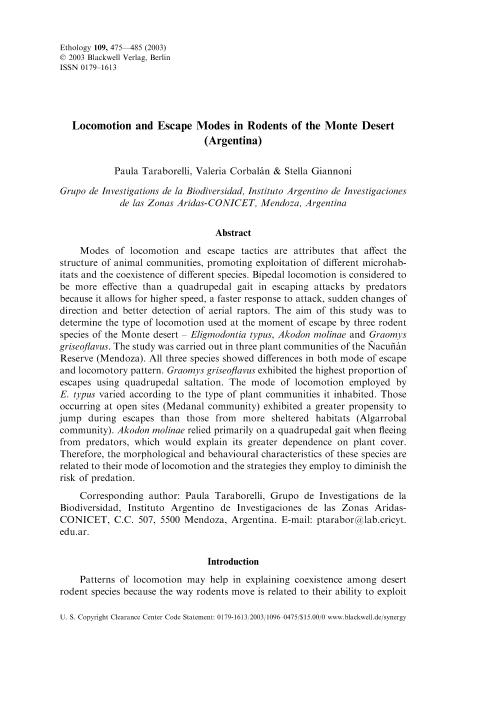Artículo
Locomotion and escape modes in rodents of the Monte Desert (Argentina)
Fecha de publicación:
06/2003
Editorial:
Wiley Blackwell Publishing, Inc
Revista:
Ethology
ISSN:
0179-1613
Idioma:
Inglés
Tipo de recurso:
Artículo publicado
Clasificación temática:
Resumen
Modes of locomotion and escape tactics are attributes that affect the structure of animal communities, promoting exploitation of different microhabitats and the coexistence of different species. Bipedal locomotion is considered to be more effective than a quadrupedal gait in escaping attacks by predators because it allows for higher speed, a faster response to attack, sudden changes of direction and better detection of aerial raptors. The aim of this study was to determine the type of locomotion used at the moment of escape by three rodent species of the Monte desert - Eligmodontia typus, Akodon molinae and Graomys griseoflavus. The study was carried out in three plant communities of the Ñacuñán Reserve (Mendoza). All three species showed differences in both mode of escape and locomotory pattern. Graomys griseoflavus exhibited the highest proportion of escapes using quadrupedal saltation. The mode of locomotion employed by E. typus varied according to the type of plant communities it inhabited. Those occurring at open sites (Medanal community) exhibited a greater propensity to jump during escapes than those from more sheltered habitats (Algarrobal community). Akodon molinae relied primarily on a quadrupedal gait when fleeing from predators, which would explain its greater dependence on plant cover. Therefore, the morphological and behavioural characteristics of these species are related to their mode of locomotion and the strategies they employ to diminish the risk of predation.
Archivos asociados
Licencia
Identificadores
Colecciones
Articulos(IADIZA)
Articulos de INST. ARG DE INVEST. DE LAS ZONAS ARIDAS
Articulos de INST. ARG DE INVEST. DE LAS ZONAS ARIDAS
Articulos(SEDE CENTRAL)
Articulos de SEDE CENTRAL
Articulos de SEDE CENTRAL
Citación
Taraborelli, Paula Andrea; Corbalán, Valeria Elizabeth; Giannoni, Stella Maris; Locomotion and escape modes in rodents of the Monte Desert (Argentina); Wiley Blackwell Publishing, Inc; Ethology; 109; 6; 6-2003; 475-485
Compartir
Altmétricas




